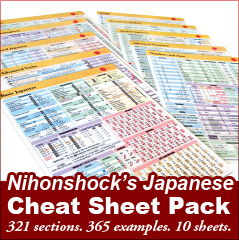Japanese cheat sheet (old)
NOTICE: This version is now old, dead, pushing up the daisies, gone to meet its maker, etc…
Alright, I so started this blog about a month ago. Posts are starting to build up and I’m starting to feel at home here lately. I decided it was time to start dishing out some real content, otherwise I’m just another ranting Japanophile. So for the last week or so I’ve been hard at work on a top secret project, and now it’s done!
I present to the world The Nihonshock Japanese cheat sheet!
What is it?
First things first: this cheat sheet is intended to be a supplement to your Japanese studies, not a replacement. The information here has been condensed, minimized, abbreviated, and generally beaten to tiny pieces with a sledgehammer in order to get as much as possible onto just two pages. This cheat sheet will be most useful for helping you to recall information after you have already learned it.
That said, even if you haven’t yet learned a lot of the grammar and words appearing on this cheat sheet, you may still find it useful as a road map to new information, and to help give what you have learned some different and perhaps better context.
How to use
Download it, print it (2 pages/1 sheet of paper front and back) and keep it in your notebook, textbook, on your desk or wherever else you need it. You can use it in it’s digital from, but owing to the small text size be prepared for lots of scrolling and zooming.
Information contained
The guide is built into the following sections:
Page 1
- Polite Verb Forms
- Casual Verb Forms
- Neutral Verb Forms
- Conjugating Verbs (RU vs U verbs and the irregular verbs suru and kuru)
- Forms of de aru (the being/equality verb)
- Adjective/Adverb form guide
- Hiragana and Katakana charts
- JLPT Level 4 Kanji Chart
Note: The katakana chart includes an aside detailing four easily confused katakana, with a stroke direction guide.
Page 2
- Core Particles with explanations and example sentences
- wa, ga, o, ni, to, de, mo, ka, e and ya
- Assisting Particles with explanations and example sentences
- yori, hodo, kurai, dake, bakari, demo, shika, kara and made
- Common grammar patterns with example sentences
- hazu, beki, wake, tame, tsumori, dake de naku, no hou ga, wake ni ha ikenai, ~EBA ~U hodo
- Regular and polite verbs of giving and receiving
Example sentences for particles are color coded to help make their parts more readily understandable. Note that the distinction between a “core” particle and an “assisting” particle I have made is not exactly the classification used in Japanese (although it’s close), but I found this grouping to be the most expedient and understandable.
Formatting notes
Paper Size
Because I imagine most people will be printing this, I’ve made two versions: 8.5×11 inch for the USA/Canada and A4 size for basically everywhere else.
Hepburn Romanization
Since this cheat sheet is targeted toward beginner to low-intermediate learners, everything is in romaji (except the katakana/hiragana/kanji charts, of course). I may release a version using the “official” romanization method in the future, but right now I’ve just made everything Hepburn (revised), because I believe it’s better for learning and the way most people will prefer. However, I have romanized long o sounds as ou instead of ō.
Serif Japanese
I’ve used a serif style (MS Mincho) Japanese font for on page 1 for the hiragana, katakana and kanji because it shows stroke direction and type better than sans-serif style (ie. MS Gothic). In this respect they can be considered a better representation of the written form.
I noticed after finishing the cheat sheet that page 2 currently uses sans-serif style Japanese hiragana. It’s a small detail and there’s no problem really, but I will probably make it serif in any future releases even if just for consistency’s sake.
What got left out
Of course I would have loved to put anything and everything on this guide (I certainly tried), but we’re talking about a whole language here, so some arbitrary unnatural selection took place. Here are some things I considered but which didn’t make the cut:
- Sentence ending particles: yo, ne, tte ba, etc.
- Some assisting Particles: sae, sura, tomo, koso
- Some verb forms: ~TE+shimau, ~E as a command
- Transitions and Conjunctions: dakara, shikashi, keredomo, tokoro de, etc.
- Honorific and Humble forms (keigo)
The particle の (no)
Yeah…. about that…..
well….. you see…..
umm…..
I kinda….
…forgot about it. (^_^; )
I’ll be sure to put it in future versions, because it’s one of the basic particles.
However, it’s also just about the easiest and most straightforward particle there is in Japanese, so its absence doesn’t really impact the overall usefulness of the cheat sheet.
Feedback
This cheat sheet will be an ongoing and evolving project for nihonshock. Although I’m confident even with the first release that this is already the best Japanese language cheat sheet on the internet, I realize it is not and probably will not ever be perfect.
So if anyone notices any mistakes, typos, inconsistencies, anything I may have forgotten, or anything that could be done better, please contact me or leave a comment and help to make this cheat sheet even better!
Compliments are also appreciated! ![]()










[…] to follow my example, start with any JLPT Level 4 kanji you don’t already know (check out my Japanese Cheat Sheet for a list), but after that there’s really no “wrong” order to learn kanji in, so […]
[…] first major project this year (other than clearing FFXIII) is to update the cheat sheet. Whereas the old one was composed in Microsoft Word, I’m redoing it from the ground up in […]